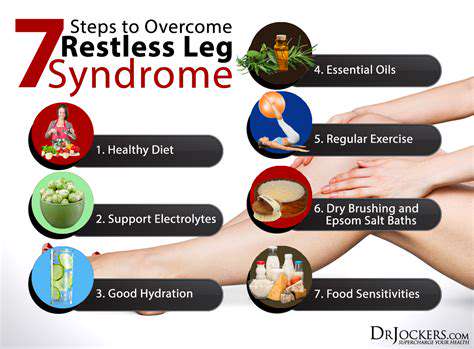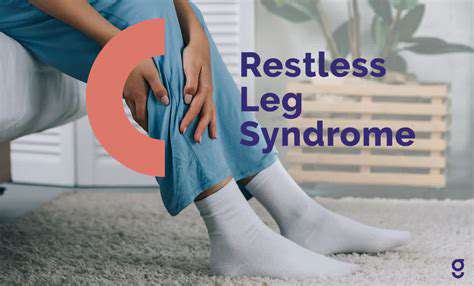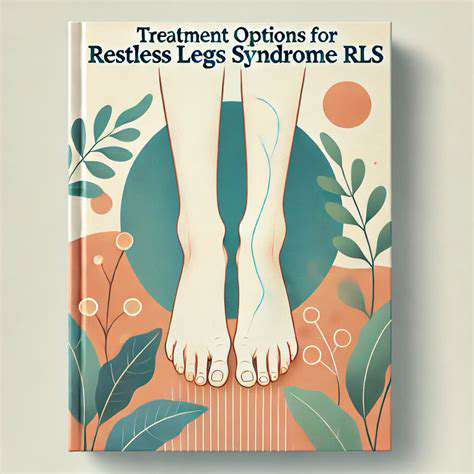Restless Legs Syndrome: Causes, Symptoms, and Treatment Options
What Are the Causes of Restless Legs Syndrome?

Genetic Factors Contributing to Restless Legs Syndrome
Restless Legs Syndrome (RLS) has a significant genetic component that can increase the likelihood of its occurrence within families. Studies have shown that individuals with a family history of RLS are more likely to develop symptoms themselves. These genetic links suggest that there may be inherited traits that contribute to the onset of this condition.
Research indicates that certain genes may influence dopamine pathways in the brain, which are crucial for movement and relaxation. Disruptions in these pathways can lead to the discomfort that characterizes RLS. Genetic variations can also affect how neurotransmitters like dopamine function, which can exacerbate symptoms in those predisposed to the condition.
Further investigations into the genetic underpinnings of RLS are ongoing, with scientists striving to identify specific genetic markers associated with the disorder. Understanding these genetic factors may lead to more effective treatments and help tailor preventative measures for at-risk individuals.
Environmental Triggers Associated with Restless Legs Syndrome
Certain environmental factors may act as triggers for individuals prone to experiencing Restless Legs Syndrome. Lifestyle choices such as high caffeine intake, smoking, and alcohol consumption can contribute significantly to the severity of symptoms. These substances can lead to sleep disturbances, which often exacerbate RLS symptoms and create a vicious cycle of discomfort.
Additionally, sedentary behavior has also been linked to increased RLS symptoms. Prolonged periods of inactivity—such as sitting for long hours at a desk or traveling on a long flight—can lead to stiffness and discomfort in the legs. This can make it more challenging for individuals to find relief, underscoring the importance of regular movement and activity.
Moreover, certain medications may trigger or worsen Restless Legs Syndrome symptoms, including those that affect dopamine levels. This highlights the need for healthcare providers to be aware of a patient's entire lifestyle and medication history when diagnosing and treating RLS.
Medical Conditions Linked to Restless Legs Syndrome
A variety of medical conditions have been linked to Restless Legs Syndrome, making it essential for individuals to be aware of their overall health. Chronic illnesses, such as kidney disease, diabetes, and peripheral neuropathy, have shown correlations with RLS symptoms, indicating that underlying health issues can exacerbate the condition. For instance, iron deficiency anemia is a particularly notable association, as low iron levels can disrupt dopamine production.
Additionally, conditions affecting the central nervous system, like Parkinson's disease and multiple sclerosis, are also linked to RLS. The intricate relationship between these neurological issues and RLS may stem from the same pathways in the brain that involve dopamine and motor control. Understanding these connections can be critical in effectively managing symptoms and preventing worsening conditions.
Lastly, pregnancy is another significant factor that can lead to the onset or worsening of RLS symptoms. Many women report experiencing RLS during pregnancy, particularly in the third trimester. This indicates that hormonal changes and fluctuations may play a role in triggering symptoms, making it necessary for expecting mothers to monitor their leg discomfort closely.
Recognizing the Symptoms of Restless Legs Syndrome

Understanding the Nature of Restless Legs Syndrome
Restless Legs Syndrome (RLS) is a neurological disorder that leads to uncomfortable sensations in the legs, often accompanied by an uncontrollable urge to move them. Many individuals describe this sensation as tingling, crawling, or itching, particularly during periods of inactivity or at night. Understanding these symptoms is crucial, as they directly impact the quality of life and sleep of those affected.
The symptoms of RLS can vary in intensity, frequency, and duration, making it a challenging condition to diagnose. Some people experience mild discomfort, while others may endure severe sensations that can lead to restless nights and fatigue. As this condition often worsens over time, recognizing early signs becomes essential for effective management.
Moreover, it’s imperative to note that RLS can often be mistaken for other medical issues, such as leg cramps or peripheral neuropathy. Therefore, a comprehensive understanding of the symptoms associated with RLS is necessary to differentiate it from other conditions and secure appropriate treatment.
Common Symptoms to Look Out For
The hallmark of Restless Legs Syndrome is an overwhelming desire to move the legs, usually accompanied by unpleasant sensations. These sensations typically worsen during periods of rest and improve with movement, such as walking or stretching. Being aware of these primary symptoms can facilitate timely diagnosis and intervention.
In addition to the primary sensations experienced in the legs, some individuals may also encounter related symptoms that cause discomfort. This includes sensations in the arms or other parts of the body, sleep disturbances, or occasional involuntary leg movements during sleep. Monitoring these signs can help distinguish RLS from similar disorders.
It’s also worth noting that the impact of RLS can extend beyond physical discomfort. Many sufferers report feelings of anxiety or frustration, particularly when their sleep is disrupted by the symptoms. This emotional toll highlights the importance of recognizing the full spectrum of symptoms associated with RLS.
Impact of RLS on Daily Life
Restless Legs Syndrome often leads to significant disruptions in sleep patterns, resulting in daytime fatigue and decreased productivity. The inability to achieve restful sleep can create a cycle of exhaustion that further exacerbates RLS symptoms. Acknowledging how RLS affects daily functioning is critical for understanding its broader implications.
People with RLS may struggle with maintaining focus and efficiency in their daily activities due to the persistent discomfort and fatigue. This can hinder performance at work, affect social interactions, and reduce overall quality of life. The ongoing battle between managing symptoms during the day and trying to secure proper rest at night can be overwhelming.
Furthermore, some individuals may experience feelings of embarrassment or social isolation due to their condition. As a result, it’s essential for those affected to understand that they are not alone, and seeking support from healthcare professionals or support groups can significantly enhance coping strategies.
When to Seek Professional Help
Recognizing when to consult a healthcare professional about RLS symptoms is vital for receiving timely and effective interventions. If the sensations in the legs consistently disrupt sleep or daily activities, it’s advisable to seek medical advice. Early diagnosis leads to better management and reduces the impact of RLS on one’s life.
Healthcare professionals may perform a variety of assessments, including a review of medical history and an evaluation of symptoms, to confirm the diagnosis of RLS. Additionally, they might request tests to rule out underlying conditions that could be exacerbating the symptoms. Patients should be prepared to discuss their experiences openly and honestly for the best support.
Finally, ongoing communication with a healthcare provider is essential in the management of RLS. Regular follow-ups allow individuals to adjust treatment plans and explore new therapeutic options as needed. Proactive engagement in one’s health can make a significant difference in managing symptoms effectively.
Treatment Options for Restless Legs Syndrome

Understanding Non-Pharmacological Treatments
Non-pharmacological treatments for Restless Legs Syndrome (RLS) can be incredibly effective, catering to various symptoms without the side effects often associated with medications. Lifestyle modifications are fundamental components of these treatments. Adopting consistent sleep schedules and engaging in regular physical exercise can play a crucial role in mitigating RLS symptoms. Many patients report significant improvement when they implement these lifestyle changes into their daily routines.
Another essential aspect of non-pharmacological treatment involves the use of leg massages or warm baths. These methods not only promote relaxation but can also help alleviate discomfort in the legs. It is common for individuals to experience temporary relief through these soothing techniques, especially before bedtime. Additionally, incorporating essential oils into massage therapy can further enhance the relaxation process.
Behavioral strategies, such as cognitive behavioral therapy (CBT), have also shown promise in managing RLS. CBT can help individuals learn coping strategies and change negative thought patterns related to their symptoms. Education on RLS is crucial; understanding the disorder can empower individuals to take an active role in their treatment. Support groups can also be beneficial, as sharing experiences with others can lead to new insights and coping mechanisms.
Pharmacological Options: A Closer Look
When non-pharmacological treatments do not provide sufficient relief, pharmacological options may be recommended. Medications for RLS are typically categorized into two groups: dopaminergic agents and anticonvulsants. Dopaminergic agents, like pramipexole and ropinirole, work by increasing dopamine levels in the brain, which can significantly reduce symptoms. These medications have been found to be particularly effective for many patients but must be monitored for side effects.
Anticonvulsants, such as gabapentin and pregabalin, are another alternative and may be prescribed for patients who experience pain associated with RLS. These medications help alleviate the discomfort linked to restless legs and can improve sleep quality. It's essential for patients to work closely with their healthcare provider to determine the most suitable medication based on their specific symptoms and medical history.
Some individuals may also benefit from opioid medications, though these are generally considered a last resort due to the risk of dependency. In addition to discussing medication options with a healthcare professional, patients should remain informed about ongoing clinical research, as new treatments for RLS continue to evolve. Finding the right pharmacological treatment often requires patience and a trial-and-error approach to find the best individual response.
Complementary and Alternative Therapies
In recent years, complementary and alternative therapies have gained traction among individuals seeking additional relief from RLS. These therapies include practices such as acupuncture, yoga, and mindfulness meditation. Many patients find that acupuncture helps ease muscle tension and reduces discomfort associated with restless legs. Additionally, yoga can promote relaxation and improve flexibility, potentially alleviating RLS symptoms.
Mindfulness meditation is another technique that has shown promise for individuals coping with RLS. This practice encourages awareness of one's body and thoughts, facilitating a sense of relaxation that can combat anxiety and stress—the two factors that may exacerbate RLS symptoms. Incorporating mindfulness into daily routines can provide not only immediate relief but also long-term benefits.
Furthermore, dietary changes and nutritional supplements can play a significant role in the management of RLS. Iron deficiency has been linked to RLS, and correcting this deficiency through dietary modifications or supplementation can alleviate symptoms. Increasing the intake of folate, magnesium, and potassium may also be beneficial. As with any alternative treatment, it's vital to consult with a healthcare provider before starting new therapies.